Late last year, the owners of the Artful Fox approached me to review their Freedom Frame. They promise that this slate frame can be dressed within three minutes. It is one of these no-sew slate frames that operate with a slot and dowel system. They sent me the 15-inch frame, which costs $205 + shipping. Converted at the Royal School of Needlework in 2010 from a strictly in-the-hand embroiderer, I greatly advocate using a slate frame for most projects. However, I know many embroiderers don’t like the time-consuming setting up of a traditional slate frame. So, any frame that promises to speed this process up would be a huge asset in the needlework community. Let’s see if the Freedom Frame delivers!
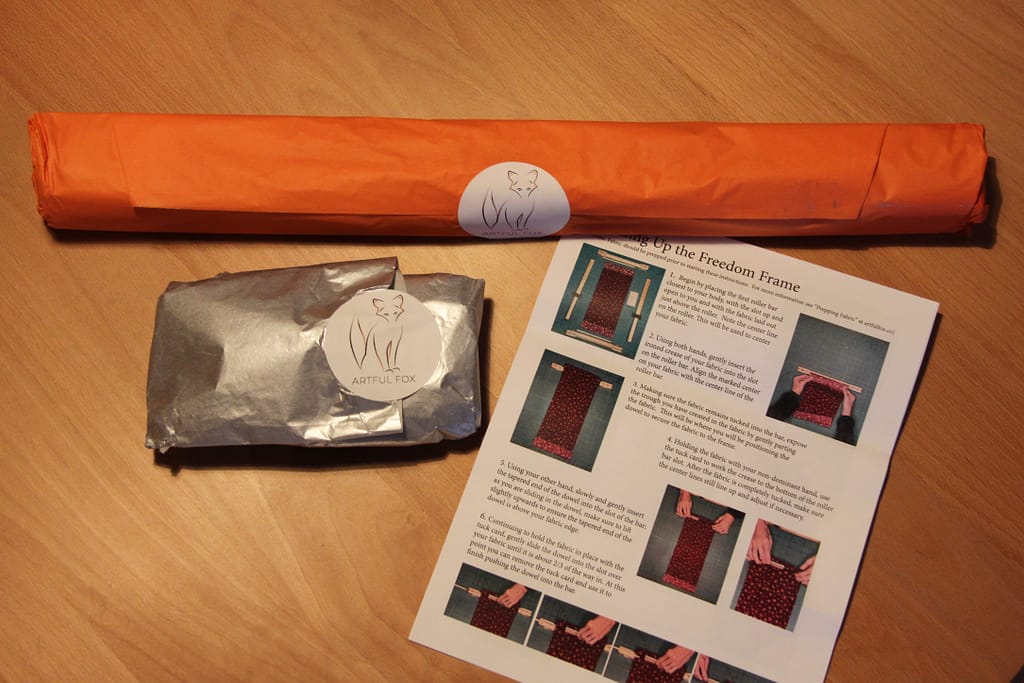
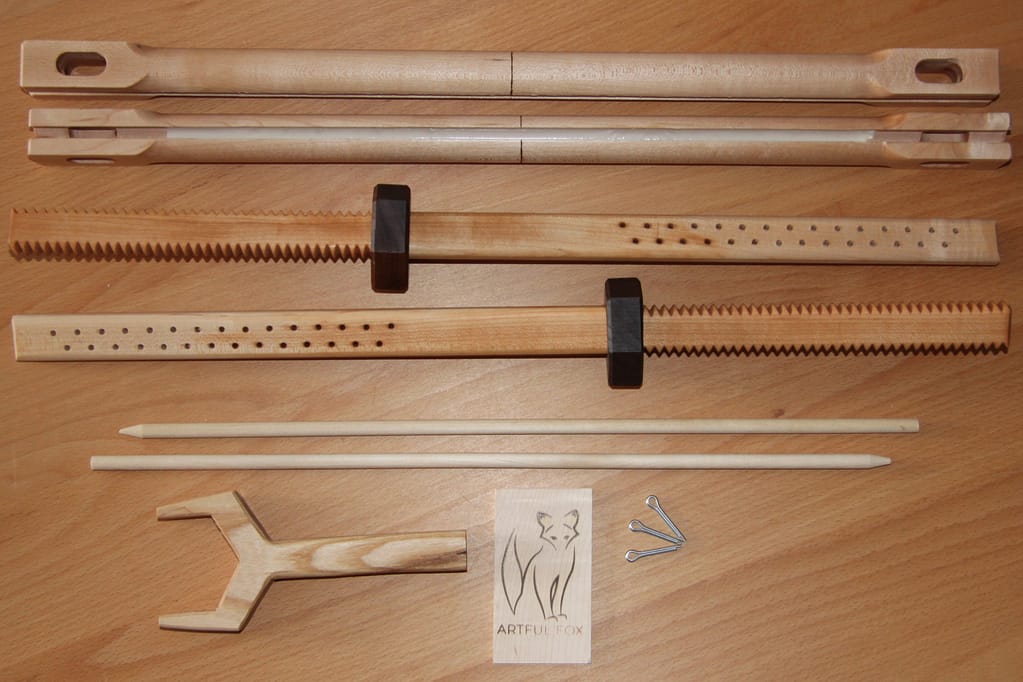
So, what does the Freedom Frame consist of? The rollers have a slot instead of a tacked-on piece of sturdy webbing where one sews on the fabric. No sewing is needed as the embroidery fabric is placed in the slot and then kept in place with a long dowel. A rectangular piece of wood is used to pack the fabric into the slot. This piece also assists with pushing the dowel in. The two slats of the slate frame have a novelty too: a rifling with a large wooden nut on one end and the traditional holes on the other. The wooden nuts make it possible to tighten the fabric in tiny increments. A wooden wrench helps with this tightening.
To test the frame, I dressed it with a piece of 40ct natural linen made by Zweigart. The slate frame came with written instructions, which referred to the website for additional instructions on how to prepare the embroidery fabric. As I could not find them, I just watched the instruction video running on the website carefully to figure it out. In addition, I didn’t like that the frame in the instructions is dressed with quilting cotton or jute (on their Instagram account), which still has the selvedge on. Selvedges should be removed as their tension is different, and leaving them on can mess up the tension of your finished embroidery (i.e. puckering).


The most important thing when using a slate frame is that my embroidery fabric is on the grain and stays super-taut throughout the embroidery process. That this takes a little bit of time and effort has never bothered me. I get the same good results whenever I dress one of my seven slate frames. After all, I don’t want any puckering when mounting my finished embroidery. So far, I never had to block any of my finished pieces. Unfortunately, using the Freedom Frame, I couldn’t get my embroidery fabric straight on the horizontal grain. When I started stitching, the fabric slackened. Please note: I did not lace up the sides as this was not part of the instructions. I also laced a traditional slate frame slat to the frame so it became wide enough to use with my trestles. I also used the Freedom Frame with my Lowery Stand.


After consulting with the Artful Fox, I was advised to use quilters ‘no slip’ hoop tape in the slot. Luckily, I was able to source some in Italy, as this is a typical American product. I dressed the frame again but had even worse results. Maybe it was my clumsiness? So, my husband dressed the frame according to the instructions. He got the same results. And, like me, he had difficulty putting the slats through the holes in the rollers. The frame is very tight, and they don’t slide in easily. We understand that this is a balancing act. There shouldn’t be too much wiggle room, either. But we feel that this is too tight. When I dressed the frame the first time, I managed to knock off tiny pieces of wood from the bottom of the rifling part. The cotter pins are also too big for the holes and are difficult to push in and remove. On the upside, the fabric did not move during stitching.
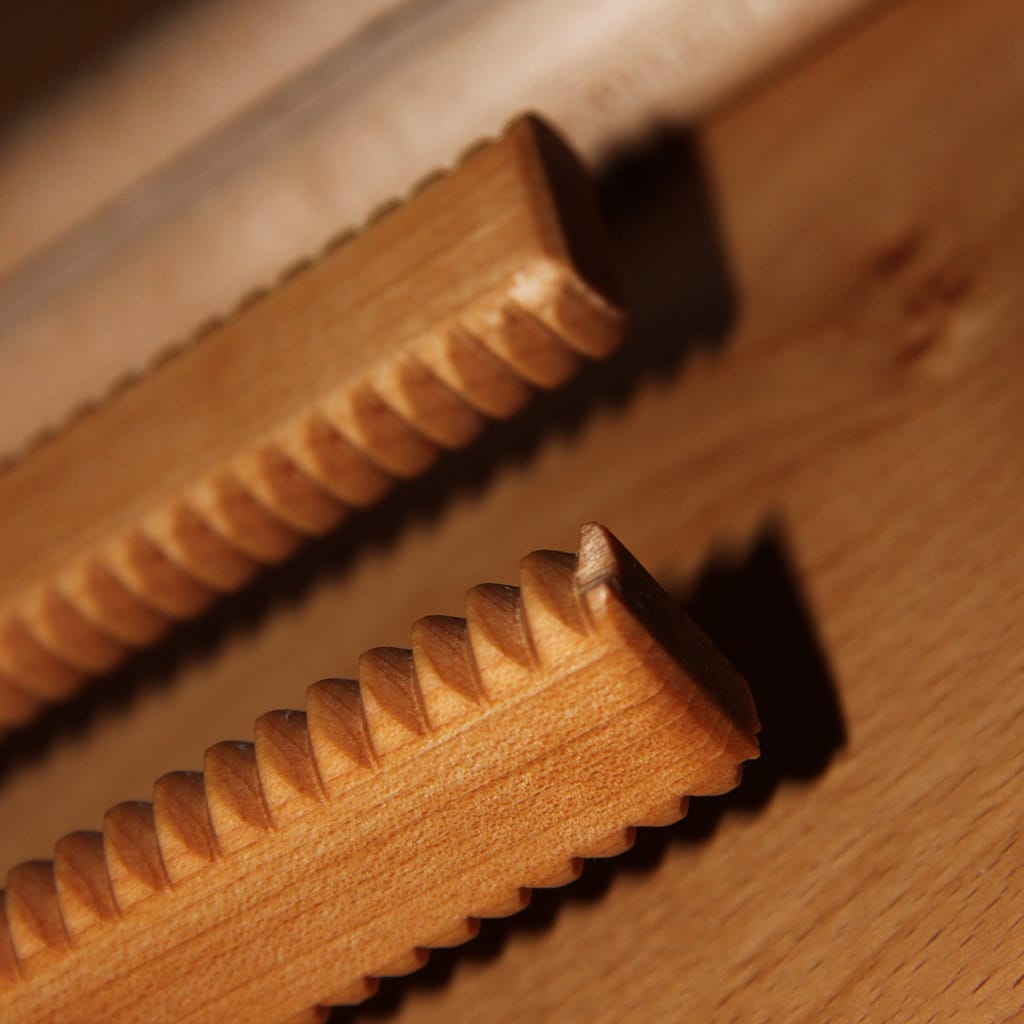
How does the Freedom Frame compare to frames offered by Jenny Adin Christie, the Royal School of Needlework, and Ecclesiastical Sewing? I own and use all three brands. The frames offered by Jenny Adin Christie and the RSN are the best in terms of woodworking and finish. The wood is smooth as silk, and the precision is immaculate. All these frames are more substantial than the Freedom Frame and weigh more. To me, that’s a good thing. A slate frame gets a beating when dressed to drum taut. The wood needs to be able to handle this without bending.
To compare prices, I looked up the 24-inch frames, as that is a size all brands offer. Prices are without postage.
- Jenny Adin Christie, 90 GBP (€ 108 or $ 112)
- Royal School of Needlework 105,67 GBP ( € 126 or $ 132)
- Artful Fox $ 235 (189 GBP or €226)
- Ecclesiastical Sewing $ 289,99 (233 GBP or € 279)
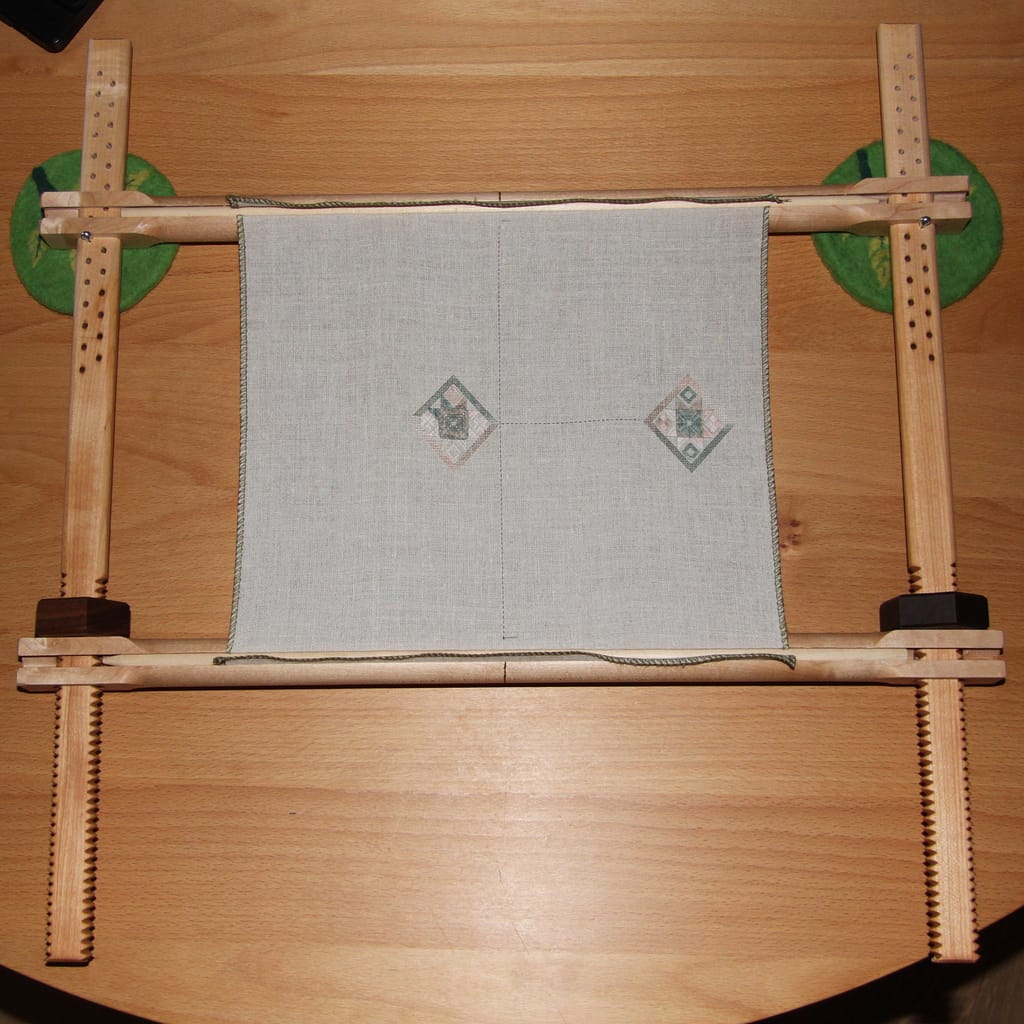
What am I to make of the Freedom Frame? I (and my husband) could not dress the frame with the same precision as I can with a traditional slate frame. And it took us much longer than the three minutes stated by the Artful Fox. That said, practice probably makes perfect. The Freedom Frame is not as sturdy as a traditional slate frame. And it is roughly twice as expensive as a high-end traditional slate frame from Jenny Adin Christie. Even when international postage is added, this is your better option.
If you would like to try the 15-inch Freedom Frame, please enter my giveaway. In the comments, let me know if you use a slate frame or not. If yes, why? If not, why? Everyone can enter, and I’ll ship the frame anywhere. Leave your comment before Sunday, February 9th, midnight CET.
update
The owners of the Artful Fox were so ‘pleased’ with my review that they demanded the frame back. I have never had companies make that request afterwards. The set of review rules on Mary Corbet’s website now makes perfect sense to me :).
Over the past month, I have invested a lot of time and money into reviewing the Freedom Frame and liaising with Artful Fox on the missing instructions and the issues I had with using their frame. I was even prepared to source that quite expensive no-slip hoop tape. It now turns out that I am the odd one out, as three RSN employees and three RSN tutors reviewed the frame and had overwhelmingly positive experiences. Well, this fourth RSN Tutor was unfortunately not impressed.
Does this mean that there is now no giveaway of a slate frame? Hell no! I have an even better deal for you. In my live classes here in Germany, my students use a 12-inch traditional slate frame from Jenny Adin Christie. I had a spare brand-new one on my shelves. That’s the new giveaway. After all, I want you to stitch with the best you can afford (or win!).
The rules for entering the giveaway are the same: Leave a comment below on whether you use a slate frame or not. And why yes or no? People who have already commented do not need to do so again; you are in the draw already. Leave your comment before Sunday, February 9th 2025, midnight CET. Good luck!
This giveaway is now closed. Thank you for all who participated. Janet Lennie is the winner of the slate frame. Congratulations!

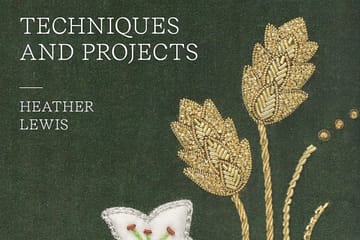

82 Comments
Kate · 30. January 2025 at 20:52
I have not tried a slate frame but have wanted to try one out for quite a while. A free slate frame would be just the inducement to get me to try one. Im retired and on a fixed income so free is just the right price for me.
I look forward to reading you weekly embroidery email blog. I thoroughly enjoy your travel adventures.
VILMA · 30. January 2025 at 21:08
I never used one slate frame. It would very nice to try and how it works. The slate frame that was shown is very nice and well made.
Mary · 30. January 2025 at 21:57
Wow. The lacing on the side was the hardest for me. This sounds like a great alternative!
Jane Frederiksen · 30. January 2025 at 22:25
I use a slate frame, also Evertite stretcher bars and hoops. My choice of frame depends on what is to be stitched, and certainly the slate frame gives the best result overall. I’ve seen these (Artful Fox) advertised, but yours is the first review I’ve seen, and I am intrigued to try them out, so would be happy to be a winner in your draw.
Mary Barry · 31. January 2025 at 0:51
I use a slate frame especially for goldwork. The one I have is probably student quality but I still find it is worth the time to set up because results are so much better. Your video on setting one up is excellent. I have watched it several times.
I am already on your mailing list and enjoy your postings.
Darcy Walker · 31. January 2025 at 1:01
I have several slates. The one with the slot and dowel is the most difficult to get the fabric hold firm. The dowels don’t grasp the fabric and it slides. I would just as soon spend the time stitching the fabric onto to tabs on dowels. Love the RSN and JAC frames. Traditional works for a reason. Darcy Walker
Sarah T. · 31. January 2025 at 3:03
Hi Jessica – I do use a slate frame for any large or important embroidery (isn’t it all important 🤭). I have three already, one of which is from Jenny. It is a lovely piece of equipment to use. I also have one with the dowel system for attaching fabric. It does save time on setting it up, however I still lace the sides. When using lighter fabric, it is necessary to add another piece of fabric to ensure it is held in by the dowels.
Thank you for your always frank review.
Victoria Wood · 31. January 2025 at 4:28
I’d love to try this new frame! I always use one because it allows me to stitch with both hands and keeps proper tension. I am intrigued by how this Freedom Frame works and want to see if setup is faster and easier than my traditional RSN slate frame.
Vivienne Cuff · 31. January 2025 at 4:47
I have bought my stands and traditional slate frame – I am sure I can dress it, but I am frightened to do so – that I can’t get the tension.
I am keen to try the artful Fox one if that going to be easier.
Jo Ann Jackson · 31. January 2025 at 5:02
I also have never tried a slate frame. I have used various stretcher bars (for needlepoint) or scroll frames (for linen)
Helen · 31. January 2025 at 7:01
I have never used a slate frame. I haven’t done any embroidery projects that required one yet. I would love to try it and maybe work up to a more elaborate frame complete with lacing.
Jacqueline Harris · 31. January 2025 at 15:55
Hello Jessica,
I do use slate frames and love them. The process of setting these up is actually relaxing!
I’ve only recently seen posts about the frame from the Artful Fox and while curious about them, I do wonder about those sides not getting laced up and how the grainline alignments might be affected…
I would be up to give it a try though!
Dr Jessica Grimm · 31. January 2025 at 16:27
Lacing the sides affects the vertical grain and not the horizontal grain :).
Janet Lennie · 1. February 2025 at 11:00
I don’t use a slate frame because I can’t afford one
Mina · 1. February 2025 at 11:12
I own a slate frame and didn’t even have to deal with the pesky process of paying custom fees to the postman. ;D
Now I only need to finally figure out getting a straight line with my needle to properly lace up the linen. Once the angels are finished, I‘ll give it some practice runs. This is getting embarrassing.
Mabel Reedijk-Pullen · 1. February 2025 at 11:30
Van jou geleerd natuurlijk gebruik ik een slate frame je werk wordt veel mooier en strakker. Veel succes Jessica
Brenna · 1. February 2025 at 11:37
I have an RSN slate frame that is excellent. It gives such a lovely firm surface for all types of embroidery. I really enjoy the process of setting up the frame for a new project.
Cindy Russell · 1. February 2025 at 11:54
I’m just finishing up my first project on a slate frame (and Alison Cole project with stumpwork), and it has been a joy! I set up the project in October and the fabric is still drum tight. I’m sold! My first frame came from Jenny Adin Christie, and I’m looking forward to my next project.
Jackie Ayres · 1. February 2025 at 12:12
I use slate frames for stumpwork and goldwork. They keep the fabric beautifully taut and leave two hands free for stitching. Sure, it takes time to dress, but I just consider it part of the process. It’s worth the result. My frames came from Thistle Threads.
Susannah · 1. February 2025 at 12:12
I have a slate frame, which was handmade by a local stitcher’s husband. I only tend to use it for really big projects, that are too big to comfortably fit in a hoop. I would love one of Jenny’s frames! I have stitched a couple of her kits and they are exceptional quality – I imagine the frames are just as good!
Chris Berry · 1. February 2025 at 12:28
Hi Jessica, My usual go to for samplers is stretchers and silk pins (not drawing pins) which work very well for travelling about on aeroplanes etc as they are not too bulky. I did buy a slate frame recently but when I made it up it was really too small for current projects but may be useful at some point.
In the past I made my own adjustable frame which did work ok but was not perfect.
I once had Rachel Kinnison as a student in a class and she made the most beautiful hand painted slate frames. Not being able to afford one of these, I would be very happy to try a plain beautiful wood one.
Thanks, Chris
Heather James · 1. February 2025 at 13:12
I love a slate frame for everything from crewel to ecclesiastical work to goldwork- anything where a drumtight fabric will show off the stitching (so that’s everything right?!).
I used a non-lacing frame (like the one reviewed) and when the fabric came out the weft wrinkled but the warp was ok- the piece looked wrong like portrait photos do in landscape mode.
Hopefully the supplier who demanded the frame back is going to make modifications!
Alison · 1. February 2025 at 13:57
I’ve never used a slate frame …yet! I’ve started to expand my needlework skills gold work and Ali it’ll stumpwork and been toying with investing in one but concerned about the investment cost…what if I don’t get on with it eek. Have been reading your newsletter posts with keen interest, thank you for sharing all that you do.
Caroline Halliday · 1. February 2025 at 14:05
I have several slate frames that I use occasionally for surface embroidery. I didn’t enter last week because of your review but if you are offering a Jenny Adin-Christie one, I couldn’t resist. Thank you for being honest. I do find the ones with dowels harder to get the fabric straight.
Ginger Scott · 1. February 2025 at 14:30
I love using my slate frame! Because they tend to be a bit pricey, I only have one. But it is actually quite versatile for different size embroideries. For small pieces, I’ve even tried to recreate the experience of using a slate frame with stretcher bars. It’s just not the same. Nothing else holds tension as well as a slate frame.
Katrin Wiens · 1. February 2025 at 14:54
I do have a slate frame but it was a cheap one from when I started hand embroidery and now it is no longer in shape ( can’t remember what wood but it’s very light) hence I no longer enjoy using it. But I love working on a slate frame and so I do need a new and sturdier one. I learned luneville haute couture embroidery in Paris and have been wanting to learn the gold embroidery. Embroidery is such an amazing and beautiful craft!
Adele Mandryk · 1. February 2025 at 15:16
I do use a slate frame. Once I was introduced to its value I have never gone back. Anything produced by Jenny Adin-Christy is fabulous, so I imagine her slate frame would be no less. Margaret Lee also makes an excellent slate frame which I used for a bead embroidery class and now use for just about all my bigger projects. Thanks for this fun draw.
Kristina · 1. February 2025 at 15:43
I use slateframes when doing embroidery but all are cheap wooden sticks that just holds together with woodpins but they work as long as you don´t do big projects with drumtight canvas. In the beginning it was hard to use them but now I can not se myself embroidering without them but I need a better stand to use with them. But it takes forever to lace the canvas on to the frame but it is worth the time.
Audrey Lauriston · 1. February 2025 at 16:11
I have a 12″ slate frame from Jenny Adin-Christie and absolutely love it! I find it essential for goldwork or silk shading to avoid fabric warping. I actually love the process of dressing it. It’s like a ritual before I start on a new project!
Lynda Harrison · 1. February 2025 at 16:54
As an aid to my preparation for a goldwork project I was directed to your site to see your piece on OA work; I did look at the rest of your website and found plenty of interest, thank you.
Over the years I have toyed with trying a small-ish slate frame and so was interested in your recent review of a frame with an innovative way of setting up; I was certainly put off this type of frame-it seems that traditional methods come up trumps! Thank you for your frankness.
In the past I have really only looked at frames from Jenny A-C so perhaps the fact that you use them is the push that I need to get one – I need to get on to her waiting list!
Sally Gandiaga · 1. February 2025 at 16:59
I’ve been using a roller frame from another company. Overall, I really like using it but am always co center about the rollers keeping my piece sufficiently taut. I’m looking to invest in a slate frame for the long haul.
Christina McClernan · 1. February 2025 at 17:06
I have never used a slate frame but would love to try one. This one does not sound like it performed that well. I generally just use stretcher bars, but I have not done many large or very involved projects yet, either.
Carla · 1. February 2025 at 17:11
Jenny’s slate frames are *wonderful*! I have four of them, all of which are beautiful and of the highest quality. (Her uncle, who is a cabinet maker, makes them for her.) I live in the US, and, surprisingly (and happily), even with postage they are less expensive than those from Ecclesiastical Sewing.
Sophie Gillo · 1. February 2025 at 17:34
I have not used a slate frame yet, but I have several on my wish list, including one from Jenny Adin-Christie. I’ve recently started learning goldwork and that’s made me want one even more. Thank you for sharing your review!
Darcy Walker · 1. February 2025 at 17:52
I love using a slate frame – keeps your work tight
And gives good room to work, rest some of your tools. Like being able to adjust slant on the trestle. Really good for large projects. Makes me a better stitcher🥰. Darcy Walker
Sharlotte DeVere · 1. February 2025 at 18:20
Jessica, I do use slate frames – mainly for gold work and stump work. I have two, both traditional style, from different makers. They are a bit different in design, but both wonderfully functional. I enjoy the process of setting them up prior to starting a new project. I also use various versions of roller frames, most often lacing the sides to the side bars to stabilize and maintain a more even tension on the fabric – usually for counted thread work or larger projects that won’t fit on my slate frames. I have a couple styles of floor stands that I use most often. Plus a set of trestles that I pull out for large projects or to get a more comfortable set up when working a project that has a tight deadline and intensive stitching.
Thank you for your honest review and offering the slate frame give away. I have two styles of roller frame that use different forms of rods to attach the fabric to the bars and I also find they can be frustrating to get the fabric set up accurately on grain. Often I find it is faster to sew or use stainless steel lace pins to attach the fabric to the traditional taped bars.
Alice · 1. February 2025 at 18:51
I have a scroll frame and a few stretcher bars for smaller pieces. I would love to get the chance to use a slate frame. I have heard very good things about them but have never been able to afford one.
Helen Sewell Johnson · 1. February 2025 at 19:03
I almost almost always use a slate frame. There is a certain elegance about the tight framed fabric that appeals to me and working with the frame on a trestle enables me to see my work and maintain a good posture. I have used frame from Ecclesiastical Embroidery and Jennie Aden Christie and both are beautifully made. In those from EE the metal pins fit so tightly that a hammer is required to install them [awkward while stretching,] and with the JAC ones the pins fit so loosely that the little rubber stoppers fall off and pins fall out [I cover the stoppers with two orthodontic rubber bands to avoid this.]. All in all, despite the elaborate preparations I feel I get a happier process and better result with slate frames.
Frances · 1. February 2025 at 19:28
I learn so much from Acupictrix newsletter and site… Im so glad you exist!!!! Medieval embroidery and illumination is so beautiful and quirky, it is such a wonderful way for storytelling. My embroidery is more like freestyle drawing and Ive never come across a slate frame but I am intrigued, especially as I am combining media oil paint and thread on linen – current projects are creating mandala like spirals and I am getting a nipple effect at the center as I cant get the drum like tension I need. Would love to be entered in the draw. Thank you for all you do!!!
Erin Rodewald · 1. February 2025 at 20:16
I have used a slate frame just once in my long years of crewel and embroidery work. It was a good experience, with a good finished product, but it was a bit fussy to get it set up.
Typically, I use a hoop. I find hoops to be convenient and portable. But I do appreciate the benefit of setting up once that the slate frame affords. And I suppose practice makes perfect—likely I would be less clumsy in the set up after several uses.
Sophie Percy · 1. February 2025 at 21:38
I love slate frames for embroidery. The tension is a must for working on. Jenny Adin-Christie is an angel.
Julie Carolane · 1. February 2025 at 22:08
I have never used a slate frame but would love to give one a try. My usual set-up is a roller frame supported by a home-made stand so that I can use both hands. I also use a hoop for smaller projects.
I’m already on your mailing list and very much enjoy your serious approach to embroidery – it’s what it deserves!
Krista · 3. February 2025 at 2:57
I do not have a slate frame due to expense, but have tried somewhat succesfully to modify a scroll frame to use in place. I would love a real slate frame to see what the deal is and in the meantime maybe hubby will make me something.
Hilary Ryall · 3. February 2025 at 12:49
Thank you, Jessica, for giving us a comprehensive review of these slate frames. I’m ready to invest in my first slate frame (I’m moving up from roller frames w the sides laced). Having read reviews, watched videos, etc I’d narrowed it down to Jenny’s, EE and RSN. The Artful Fox did not make my list because the “no side lacing” makes no sense to me. Anyway, thanks again for an informative review — and thx to your other commenters for their advice, too!
Maísa · 3. February 2025 at 14:55
I haven’t tried a slate frame yet – they scare me a bit. I would love to conquer that fear and try one.
Dima Santina · 3. February 2025 at 15:10
I use a slate frame. I actually have quite a few, one from the RSN and 6 made for Japanese embroidery. They are my preferred method of stretching fabric. I hate hoop marks and you can never get that nice taut stretch. I’ve been wanting to purchase a frame from Jenny Adin-Christie that I could use for smaller projects.
Terese Trebilcock · 3. February 2025 at 16:04
I have never used a slate frame, but I would love to try! I usually work on a scroll frame, and do a l9t of re-tightening. Thank you for this opportunity!
Carla Bowlin · 3. February 2025 at 16:05
Yes, I use a slate frame and could certainly use one this size. The fabric can be stretched so much tighter than a hoop.
Stephanie Wright · 3. February 2025 at 16:29
I use a slate frame for most things because it is the best way to get a nice taut stretch. The time taken to set up a piece of embroidery is well worth the end result ……… and you get quicker at framing up the more times you do it!
I do use a hoop for small cross stitch projects
Catherine Marshall · 3. February 2025 at 16:31
An exciting giveaway! I’ve never used a slate frame but would love to try. I have two projects, one a small Jenny Adin Christie gold work kit, that would be perfect for working on a slate frame.
Marjan Kuyken · 3. February 2025 at 16:35
I’m often a ‘stitch in hander’ but know there are certain things that need the extra tension and always have a number of projects that need frames, with Jenny’s being my preferred frames. I currently have a number of projects on the go, mainly goldwork.
I have one that just needs one more motifs finishing, so I’m off to see if I can complete that one now.
Helen Clarence · 3. February 2025 at 16:54
I have used hoops, roller frames and slate frames. The one I like the best is the slate frame because once laced on I dont have to worry about it again whereas a hoop you are constantly adjusting. I dont mind the time it takes (its not that long) and I actually find it quite medatitve to do.
Claire B Marcus · 3. February 2025 at 16:54
I have not used a slate frame, but would love to try one. My seat frame is excellent but I cannot see all of my work at one time. Thank you for sharing so much historical context with us!
Vanessa Richards · 3. February 2025 at 17:14
I don’t typically use a slate frame, mainly because so many of my projects are started in classes where there isn’t enough time to dress the frame. I would like to try using one without that time constraint.
Daisy · 3. February 2025 at 17:26
My old slate frame has a couple of parts missing . So I’ve been doing my embroidery without one . I wouldn’t mind a nice new state of the art one ! Please enter me if you are able to include U.K. No worries if you aren’t and good luck to everyone entering .
Dr Jessica Grimm · 3. February 2025 at 17:31
Yes, I ship worldwide!
Sarah Jackson · 3. February 2025 at 17:30
I have used slate frames before, but not Jennie’s frames. I love stitching on slate frames. Thank you for this opportunity.
Barbara Gilbert · 3. February 2025 at 17:32
i do use a slate frame on large pieces that will take a longer time to stitch. My husband has made trestles for me and the slate frame on the trestles is my preferred method of stitching.
already on your mailing list and love the extra patreon offerings!
Amy Pilgrim · 3. February 2025 at 17:36
Actually, Dr. G., I have a slate frame I bought from TF Woodcraft on Etsy, and I’m ashamed to say that I have never used it, nor even attempted to use it! Although, in my defense, I moved before I could use it, and I lost the cotter pins. I messaged TF Woodcraft, and they sent me more — free of charge! — but, alas, I still haven’t used it. I would LOVE to win one from Jenny Adin Christie, though! *SIGH* I guess I need to get off my back side and get with it. I’ve stared at, drooled over, and longed for this stuff long enough; I guess 2025 is the year to take the plunge.
Dr Jessica Grimm · 3. February 2025 at 17:39
LOL, perhaps I should set up an anonymous self-help group for virgin slate frame owners?
Rebecca · 3. February 2025 at 17:58
I do use a slate frame – sometimes. There’s nothing better for taut, lasting tension for goldwork, and there are no hoop creases to be concerned about. But I don’t enjoy the work of dressing the frame, and after stitching a framed project I find myself longing for a hooped or held-in-hand project that I can work while putting my feet up.
Michele Hunter · 3. February 2025 at 18:24
I love slate frames! The even tension you can achieve is perfect. The work stays smooth and unrivaled, meaning less blocking.
Mary Knapp · 3. February 2025 at 19:05
Hi Jessica, This is new to me. When I took Alison Cole’s Lavender Sparkle goldwork butterfly class, I stitched it in a hoop. Many years ago my husband built me a beautiful standing frame for large pieces and I have learned over the years of using it some ways to adjust for smaller ones that call for a lot of lacing. I will have to look into this. Sounds like a winner.
Mary I am already on your mailing list.
Jo Taylor · 3. February 2025 at 20:01
I use several slate frames and have RSN ones and one Jenny Adin Christie one as well as some old floor standing frames from my granny for practice pieces. It is time consuming to set up but once you’ve done it a few times you get quicker and thr fabric stays nice and taught. I have never used roller frames but anyones work I’ve seen in them always looks too loose.
Gail Horn · 3. February 2025 at 21:09
I have three slate frames, two occupied by projects I’ve started under your tuition. As I’m back with you soon, I could really do with another one as I love using a slate frame. I know, I’m selfish in wanting another one, but there you go!
Glenys Collie · 3. February 2025 at 21:40
I have followed the debate over this frame from various groups of embroiderers and of course have given my opion which is….I have a millenium frame purchased many years ago at a huge price that I dont like as its very heavy and doesnt keep the fabric firm enough down the sides and as this frame is similar in its design I would say sight unseen it would be not as acceptable as a scroll or slate frame which you can lace to drum tightness. These frames are better because when it comes to framing your piece the taughtness of the fabric depends on a good finish for the duration of the embroidery for many years.
Anne Mshoney · 3. February 2025 at 21:47
I am just now becoming serious about samplers. In the past, I have worked in hand on small things. I believe a slate frame would be most helpful. My thanks for your instructions and honest reviews!
Dagmar · 3. February 2025 at 22:13
I worked with a professional slate frame the first time when I was joining Jessica`s embroidery workshop in Halberstadt last year in September. While it took some time to set it up, I found that it was really worth it. I was impressed and surprised at how much more comfortable and precise it is to work with. When you consider how much work and effort you put into creating the embroidery, it’s a shame if the end result is ruined by the effects of an inferior frame. Unfortunately, I’ve had this experience myself. That’s why I will never work without a professional slate frame set-up again.
Tim Buchheim · 3. February 2025 at 22:33
I started using a slate frame when I began working on my 17th century stumpwork casket (although I’ve now used it for some other projects as well). The slate frame was included in the course (the Four Seasons Double Casket by Thistle Threads) and it’s a flimsy one sold by Access Commodities.
While Access Commodities has a wonderful assortment of threads, I’m not particularly impressed by the slate frame with its thin pieces of wood and useless pegs. I need to get a better one, but they’re expensive. The one sold by Ecclesiastical Sewing looks nice enough, but the price is double what it ought to be. (This goes for everything Ecclesiastical Sewing sells, not just slate frames.)
Shipping from the UK is absurd these days, so I’ve been hesitant to order one from the RSN or from Jenny Adin Christie. (Although at some point I’ll have to order some of her wonderful threads, so when I do I may also get a slate frame or two from her as well.)
I recently ran across T.F. Woodcraft, whose slate frames look much better than the Access Commodities ones. If I don’t end up getting one from the UK then I’ll probably try one from T.F. Woodcraft. They even make trestles!
Mary Barnard · 4. February 2025 at 0:52
I use a tambour frame which is a type of slate frame. It allows me to work on larger projects and maintain tension. I don’t have to fiddle with my fabric as much on it. The one I have is five feet long. I hope to one day pursue a certificate with the Royal School of Needlework, but once my youngest is in school.
Lynley · 4. February 2025 at 2:38
On reading your review I feel this style of frame would be better suited to a project that needs some stability but not extreme tautness required of goldwork. Something like sampler work or canvas work.
I do quite a lot of this and an extra frame would free up my slate frame for the gold work projects (which, if I’m being completely honest, take A LONG time to complete)
Thank you for taking the time to not only test it out, but to share your opinion.
Carol Ann Woidke · 4. February 2025 at 3:54
I had heard of a slate frame but, hadn’t used one until 2016. For me there was no going back, I became a slate frame convert. I’ve heard people say it takes too long to dress the frame. Yes it requires a bit of time but, I find dressing a frame quite relaxing and enjoyable. I’ve not had to block a piece worked on a slate frame and I love the drum tight tension of the ground fabric. I highly recommend using a slate frame, it makes doing your embroidery so much more enjoyable.
Cheryl akealy · 4. February 2025 at 4:50
I was originally introduced to slate frame use at the RSN 15 years ago. Since then I have championed their use and have won over a few converts at my local Embroidery Guild. Jenny’s smaller slate frame sounds perfect for smaller projects nd travelling. Thank you for your honesty in your review – it is much appreciated. Slate frames are a significant investment for keen stitchers, so it’s important to invest wisely. Your newsletters are always interesting and educational.
Kitty pittman · 4. February 2025 at 5:28
I have not tried a slate frame. All the talk about using one makes it seem like a game changer. Price was also a consideration. Fibertalk folks rave about working on one.
Margaret Morgan · 4. February 2025 at 6:44
I have several slate frames of varying quality. All but one has been made and purchased in Australia. They are not particularly well finished, but certainly do the job. The last frame I purchased from an Australian embroiderer who has a shop and it was made in the USA. It has been finished beautifully, however the pegs do not fit the holes – so I am back to split pins! I do prefer slate frames to work on because the work stays drum tight and the results are great. At present I am working on a stretcher bar frame with fine linen and a fine cotton underlay. I am going to have to re-tension the pins on the frame. 😞
Christina Nevin · 4. February 2025 at 6:59
I have only stitched small pieces so far so haven’t used a slate frame.
Christine Burton · 4. February 2025 at 11:58
I have used slate frames and can agree there are those in the market that do the job immaculately and then there are those that are sadly not up to the task. I agree with you Jessica that the straightness and weight of the timber plays a huge role in getting the fabric taut and equally tensioned on all four sides. Certain timbers are more suited to this.
Like threads, a girl can never have too many slate frames!
Tammy · 4. February 2025 at 13:17
I only used a slate frame ones. Maybe the one I got is just too big for me but I didn’t enjoy stitching anything further away then the middle. It took me half a day to set it up (your instruction video was so helpful) and I missed the ability to turn it according to the stitch direction when doing a satin stitch too much to use it regularly for whitework.
However it was awesome not to worry about tension so I want to test it for gold work in the future but the size and setting up is quite a hurdle at the moment. So maybe this smaller one would be a better fit.
Vickie Green · 4. February 2025 at 14:48
Dear Jessica, thanks for such wonderful content you give to all of us! I bought my only small slate frame because of you! I think the effort to set it up is worth it without question. I’m a weaver and bobbin lace maker so “slow process “ is rewarding for me and I understand the value of set up to the final result.
I’m glad you were honest about your review and thier resulting actions speak volumes about why I would not want to have anything to do with that company.
sharonp · 6. February 2025 at 19:11
Yes, I use a slate frame for gold and stump work. Rachael Kinnison, Diamond K Folk Art makes and paints all sizes and I have also used Jenny’s. Personally I like the painted ones just because the drawings (which I selected) often match what I am stitching. On other occasions a sit on frame is preferred.
Jurgita Piotrowski · 7. February 2025 at 22:15
I haven’t used any type of slate frame since I’ve only done cross stitching. Now, that I’ve been researching goldwork and Luneville embroidery to try, I know that slate frame should be the best frame for that. Since those type of frames were used in the middle ages, I’ll need to use them if I want to recreate it’s style and design form myself.
That was strange how this company reacted. I think good store would try to change person’s mind with suggestions how to use their product better..
Christene · 9. February 2025 at 3:11
I love stitching with a frame. I use my “millennium” frame for my goldwork pieces. The :millennium” frame is very similar to the Artful Fox frame. I found that it stayed very taut and I did not need to lace the sides. Love your newsletters!!